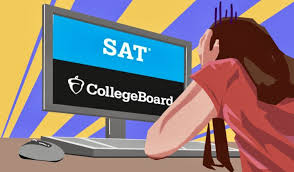The Digital Developments of the SAT

Source: https://ucsdguardian.org/2022/02/06/sat-goes-digital/
November 26, 2022
The SAT has been taken physically since its inception almost a century ago. With the Covid-19 pandemic looming in the background, College Board has set out to change that. Being one of the most pervasive standardized tests, major changes would affect millions of test-takers across the nation. The new digital format moves SAT tests from paper to laptops. This does a few things:
- The scoring process is significantly faster, as Scantrons do not have to be scored and re-checked. Digital scores can, in theory, be evaluated instantaneously.
- Calculators will be on laptops, which prevents the annoyance of complying with College Board’s strict calculator rules.
- The risk of grading machines misinterpreting erased answers has been removed, since this is all handled electronically.
This format was an unprecedented move for College Board which thus far, in its 120-year history, had all of its exams on paper. This conservatism contrasted with the progressivism of competitors, such as Pearson, a major player in higher-level standardized assessments, who transferred their examinations to digital vehicles in previous years. Even competitor ACT Inc., responsible for the administration of the ACT exams, had started the shift in 2018 prior to the pandemic, highlighting College Board’s often slow tendency to react. The 2020 digital administration of the AP exams, propelled by the lockdown, was in many regards a failure. It was widely broadcasted that some exams had failed to submit prior to the deadline, that there was negligence in inappropriate timing for students in distant time zones, and that the controversy resulted in a lawsuit. During that time, SAT exams were canceled, and colleges had to adapt to a novel situation by providing a “test-optional” application, an unprecedented transition in the application process.
The new digital format also brings along many crucial changes to the design of the test. The reading section, infamous for its long passages and complex questions, has undergone an overhaul. Passages will be shorter and each will have only one related question. The math section will no longer be split into ‘calculator / no-calculator sections’ but will instead allow for a calculator throughout the test. This gives less of an emphasis on “mental math” and evens the playing field for students who have not learned math fundamentals with speed as a main focus. In lieu of the previous three-hour test, this new test has been abridged to just two hours, perhaps assuaging the fears of those who experience burnout at the end of a long test. This move seems to be a part of a new overhaul in College Board’s system of examinations, accreditations, and certifications. Though a long-term process, this change was accelerated by the pandemic, where students saw the SAT evolve from a long-gone standardized exam with abstruse vocabulary and far-reaching math concepts to a beast much closer to the classroom environment. This included the removal of controversial sections like the essay. In addition, superfluous options that were offered were eliminated, such as the redundant SAT II or subject tests and AP Exams.
It is now clear that the latest step in that process was this transformation of College Board’s pinnacle exam, the SAT. It seems that the College Board is focusing on making this test easier, so more students are enticed to participate. Priscilla Rodriguez, Vice President of College Readiness Assessments at College Board, notes that the “digital SAT will be easier to take, easier to give, and more relevant.” Her emphasis on relevancy is interesting, as relevancy is a primary source of revenue for College Board. One might even argue that it is the revenue. College Board makes money by creating and administering tests. Each student who takes the SAT or an AP exam must pay a fee directly to College Board for revenue. The more relevant the tests are, the more profit.

